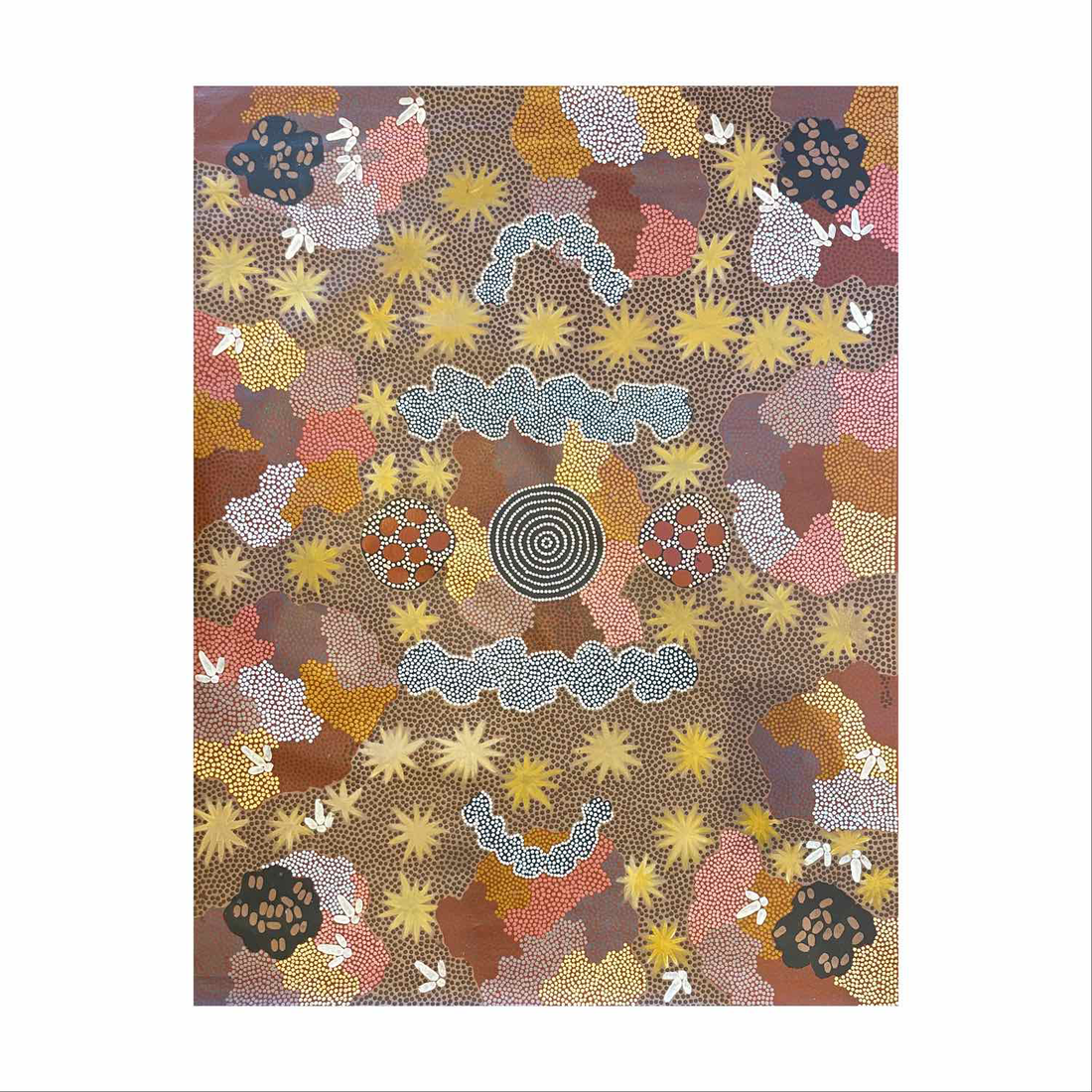
Warlugulong by Clifford Possum Tjapaltjarri: A Masterpiece of Dreamtime Storytelling
Share

Clifford Possum Tjapaltjarri is acknowledged as a major presence in Aboriginal art, a skilled storyteller whose paintings shared the history of the Dreamtime worldwide. Among his much-admired paintings, Warlugulong (1977) is regarded as a key masterpiece bursting with tales of ancestors, detailed symbols and rich knowledge of his culture.
This painting is not only an artwork, but it also offers a visual collection of Anmatyerre Dreamings, among them the powerful and meaningful tale of Lungkata, the Blue-Tongue Lizard Man. It is valued and loved because of its intricate beauty and its ability to express the spiritualism and relationship to land shared by many Indigenous Australians.
Who Were the Jungala Brothers?
Clifford Possum Tjapaltjarri (c. 1932–2002) and his brother Tim Leura Tjapaltjarri (c. 1929–1984) were Anmatyerre men and key figures among the founding artists of the Papunya Tula art movement in the early 1970s. While "Jungala" is a skin name that both men shared, they are more commonly referred to by their given names within the art world. Both brothers played pivotal roles in the genesis of contemporary Western Desert art.
Their contribution to the early growth of Aboriginal painting was immense. They were some of the first people to recreate food, sand and ceremonial designs on board and canvas. It was Clifford’s precise work, unique ways of creating compositions and skill at uniting several Dreaming legends into a large composition that set him apart.
Tim Leura’s paintings were valued for their quiet, mysterious and sombre style. Individually and as a group, the elder men played a key role in forming the Papunya Tula style, with Warlugulong becoming known worldwide and shifting how people saw Aboriginal art. Clifford Possum Tjapaltjarri's Warlugulong is itself evidence of this important artistic time.
Warlugulong: The Painting That Changed Aboriginal Art History
The Warlugulong painting from 1977 is considered a major achievement in the art of Australia.It is a masterpiece with an even greater history. The details and composition of this timeless masterpiece is as follow:
Composition
You can see many Dreamings overlapping in this painting, with Aboriginal symbols joining other figurative features in an engaged interplay. The ancestors’ journeys and contacts with each other are shown in the artist’s country, all connected by the major site of Warlugulong. Different parts of the story are organised carefully, so that each narrative remains easy to follow and identify.
Size
It stands at almost 8 x 12 feet and its impressive size makes the story really come to life.
Mediums Used: Clifford Possum Tjapaltjarri made Warlugulong by applying synthetic polymer paint (acrylic) on a canvas.
Auction History
In 2007, Warlugulong sold at Sotheby's in Melbourne for AUD $2.4 million, setting a record for the most paid for an Aboriginal artwork at auction. The sale achieved a major milestone that brought Indigenous Australian fine art to wider international recognition.
Milestone
Warlugulong is important for its wide-ranging, detailed narration of Dreamings, its detailed composition and its unmatched effect in winning recognition worldwide and a strong market presence for Aboriginal art. It demonstrated the profound depth, complexity, and aesthetic power of Indigenous Australian visual traditions to a global audience, challenging Western art hierarchies.
The Meaning Behind Warlugulong
Warlugulong is significant because it shows, in detail, Clifford Possum Tjapaltjarri’s region and its many Dreamings. The Warlugulong canvas has images of holy sites, ancestral paths (songlines) and stories of the beginnings that make the landscape sacred.
There are many interconnected Anmatyerre Dreamings making up the story, not just a single one. Among these stories are those about the Upambura (Possum) Dreaming, Mala (Rufous Hare-wallaby) Dreaming and the two Jangala (Kangaroo Men) and, most importantly, the Lungkata (Blue-Tongue Lizard Man) Dreaming.
Evidence from skeletons, footprints, tracks and symbols for waterholes, campsites and special rituals are cut together into the rock base. The painting displays how well the artist understood his nation, its significant past events and the way people are meant to live on the land. It is a visual assertion of cultural ownership and ancestral authority.
Lungkata: The Blue-Tongue Lizard Man
Among the countless tales in Warlugulong, that of Lungkata, the Blue-Tongue Lizard Man, is most important and teaches a valuable lesson. The character of ‘Lungkata’ in Aboriginal myths: ‘Lungkata’ is a much honored ancestral being in Central Australian Aboriginal mythologies of the Anmatyerre group. He is frequently illustrated as both greedy and deceitful.
The Lungkata Dreamtime Story
The Lungkata Dreamtime story tells of Lungkata finding a killed kangaroo. Instead of sharing it with his two sons as custom dictated (or, in other versions, with the hunters who had actually killed it), he greedily cooked and ate most of it himself in a cave. He then lied to his sons, telling them the kangaroo had run away. However, the smell of the cooked meat and the grease around his mouth gave him away.
Its Themes of Morality, Punishment, and Fire
The Lungkata story is a morality tale about the importance of sharing, honesty, and adherence to social law (lore). Lungkata's greed and deceit led to his punishment. His sons, angered by his actions, set fire to the cave where Lungkata was hiding. He tried to escape, but the fire was too intense, and he perished. The fire, a central theme, is depicted in Warlugulong as a destructive and transformative force, originating from Warlugulong itself, a site associated with this fire event. The smoke and ashes from this fire are said to have stained the rocks at this location.
How this Figure is Depicted in Warlugulong
In the Warlugulong painting, the Lungkata episode is graphically represented. The cave, the fire, and the skeletal remains of Lungkata (and sometimes his sons, depending on interpretation and specific story versions) are key elements. The blackened areas and fiery reds and oranges signify the bushfire started by his sons (or, in some tellings, by Lungkata himself accidentally or as a consequence of his actions).
The Lungkata Walk and Songlines
The Lungkata Walk refers to the ancestral journey or songline of Lungkata across the landscape. Songlines are the paths an ancestral being took during the Dreamtime, creating the landforms, sacred sites, and natural phenomena we see today. These paths are recorded in traditional songs, stories, dances, and visual art, including paintings like Warlugulong.
The painting shows the way of Lungkata and includes the main location where the fire event occurred. The sequence of tracks, topography and symbols are used by initiated people to bring back the details of the Lungkata story and the sacred sites covered during the Lungkata Walk.
Using this system, the artwork links the land, the story and the painting together, making it clear that Aboriginal art functions as both a cultural map and a way to represent spiritual places. Ways of portraying songlines help express that we belong to and are responsible for our Country.
Legacy of Clifford Possum Tjapaltjarri and Warlugulong
The mark left by Clifford Possum Tjapaltjarri in both Aboriginal and Australian art is major. He led the field of contemporary Indigenous art by pushing limits and making works that were both complex and beautiful, appreciated all over the world. By combining sacred designs with a unique layout, he gave the Papunya Tula movement and its artists greater acclaim.
The Warlugulong painting is constantly inspiring artists, collectors and scholars. Because it is valued, it is placed in the National Gallery of Australia, helping to safeguard it for coming generations. Warlugulong and other artworks by Clifford Possum Tjapaltjarri have attracted worldwide attention in important international shows.
The painting continues to show how Anmatyerre culture, law and connection to Country are held strong over time. Clifford Possum Tjapaltjarri Warlugulong stores cultural knowledge and remarkable art in one object.
Final Thoughts
Not only does Clifford Possum Tjapaltjarri’s Warlugulong painting impress with its beauty, but it also shares important cultural meaning and keeps sacred details. The many fine details and meaningful stories such as the Lungkata Dreamtime, make it clear why these dreamtime stories should be preserved using colorful artwork. From Warlugulong, we see that land, spirituality, law and art are all closely connected for the Yolgnu. Such masterpieces ensure that the wisdom of the Dreamtime continues to resonate and educate generations to come.
Experience Dreamtime Art at Mandel Aboriginal Art Gallery
To see the power and picturesque side of artworks based on ancient Dreamtime tales, we encourage you to visit Mandel Aboriginal Art Gallery. Feel free to browse genuine and ethically made Aboriginal art pieces that give a glimpse into their customs and long-lasting stories. Each painting and other artwork of the Lungkata journey gives us a distinct look at a culture that has existed for thousands of years.

